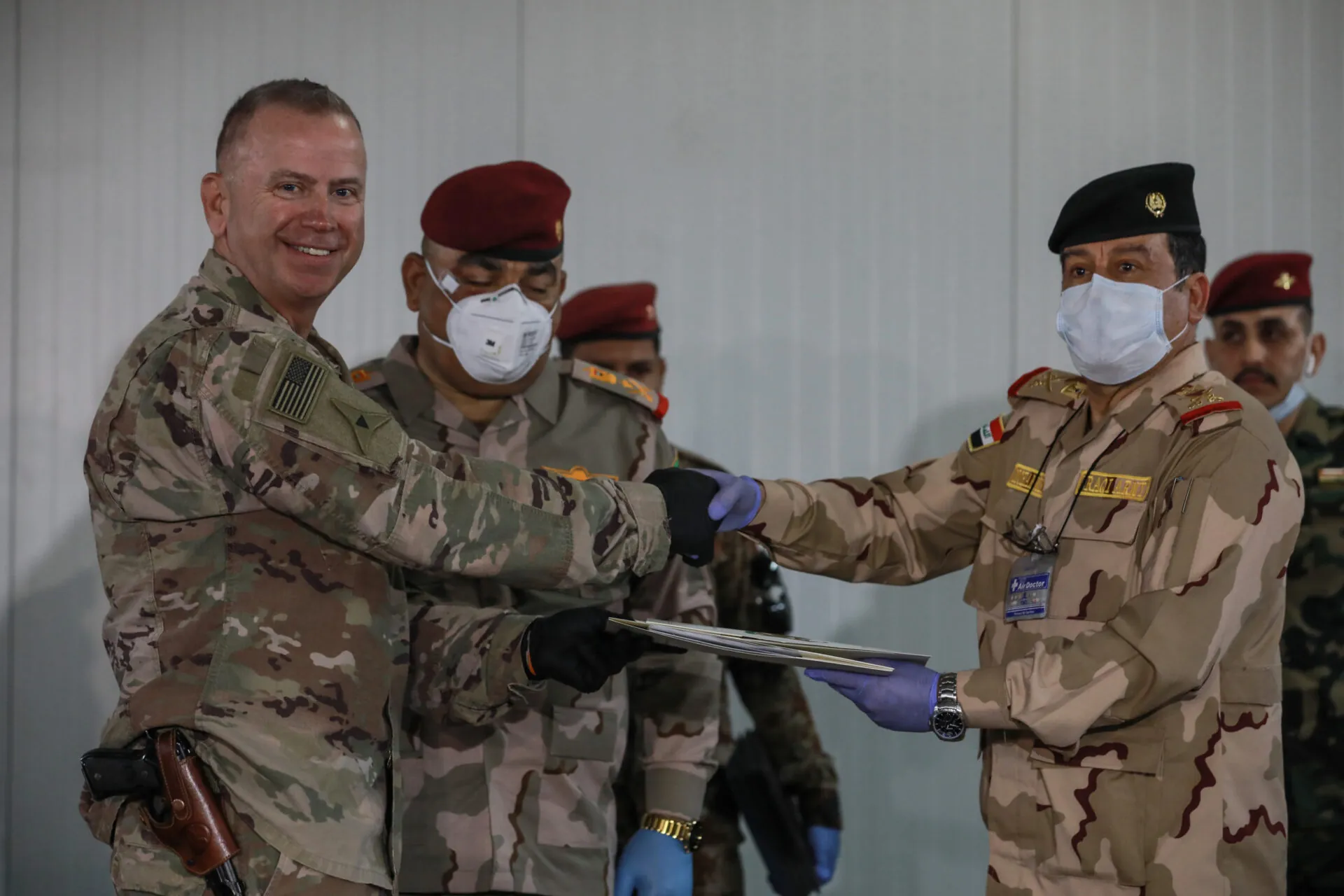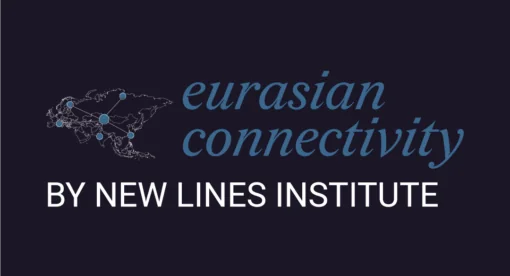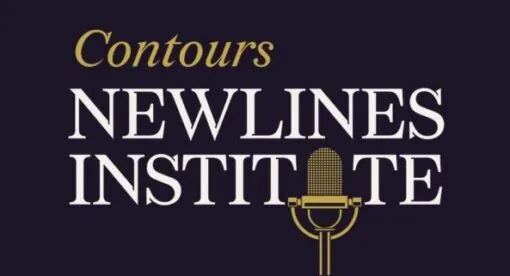The Biden administration should draft a country-specific policy for Iraq, where addressing Iranian influence is an objective but not the defining imperative. U.S. Iraq policy should include a diverse array of opportunities beyond the realm of defense to boost Iraqi autonomy.
After months of paused anti-ISIS operations and joint trainings, numerous base transfers and large-scale redeployments, a weakened Iraqi federal government, and a recent string of attacks from Iran-aligned militias, the Biden administration is inheriting a complicated position in Iraq.
Despite pressures to further draw down, it is unlikely the administration will choose to dramatically clip American force projection in the country. While the 2018 National Defense Strategy’s prioritization of China and Russia and defense budget cuts will constrain any move to surge U.S. presence in the Middle East, the U.S. retains the imperative to keep Iraq – with its important trade routes, natural resources, and ability to affect continental security – stable. And despite promises to revive the JCPOA nuclear deal with Iran, Washington still has a key interest in constraining Tehran’s aggressive posturing through its use of proxy militias and allied regimes in the Middle East.

As it stands, the U.S. has two concurrent strategies in Iraq: one countering ISIS with Iraqi armed forces, institutionalized as the Combined Joint Task Force – Operation Inherent Resolve (CJTF-OIR), and the other informally countering the growing threat of Iran-backed militia activity – objectives that should be assessed in Washington on their own merits. The Biden administration’s challenge in Iraq will be how to strike the appropriate balance between force allocation, political influence, deterrence, and averting instability that could once again create a power vacuum in Iraq and pose long-term threats to regional and transcontinental security. A weakened Iraq could open the door to large-scale conflict, affecting trade routes and freedom of navigation, access to natural resources, great-power competition, and migrant influxes into the Middle East and Europe, and it has the potential to spark violent overspill into the broader region.
When it comes to force allocation in Iraq, the Biden administration should seek to establish a country-specific policy, divorced from the Trump administration’s “maximum pressure” campaign against Iran, that addresses some of structural weaknesses of Iraq’s security landscape, not just the symptoms.
Inheriting a Scale-Down
While the Pentagon had been preparing for a scale-down of its CJTF-OIR mission in Iraq since 2017, it was escalation between the U.S. and Iran over the killing of powerful Islamic Revolutionary Guard Corps (IRGC) Gen. Qassem Soleimani in January 2020 that tipped the scales, inducing a withdrawal of over 2,700 personnel in less than a year. What first sparked the drawdown was not an Iraqi parliamentary vote to expel U.S. forces in the fallout of escalation but rather ballistic missile strikes on the Ain al-Asad air base in western Anbar province from the IRGC mission codenamed “Operation Martyr Soleimani.”
The attack proved that Iranian strike capabilities were advancing, rendering many of the OIR bases vulnerable; the physical force of the 10 missiles was so overwhelming that it blew soap dispensers off of walls, stopped electric generators, and created large craters filled with rubble. Personnel only had minutes to hide in the base’s bunkers, which led to 109 American personnel receiving traumatic head injuries. Ain al-Asad’s bunkers, along with a number of other high-value American defensive postures and assets in Iraq, were designed with risk matrices for unguided, rocket-propelled projectiles, not integrally guided ballistic missiles that have greater potential to make direct impact and do more damage. Ain al-Asad proved to be a major wake-up call for the U.S. mission in Iraq, convincing CJTF-OIR and the U.S. Central Command that its spread-out force posture and larger bases made its forces dangerously exposed to successive attacks from the IRGC and aligned Iraqi militias, particularly as Iran’s ballistic missile program advances.

For the latter nine months of 2020, the U.S. carried out a fast-paced withdrawal strategy, pulling assets and personnel from eight bases, including strategically important locations at al-Qaim, Kayan (K-1) Air Base, Camp Taji, al-Taqaddum Air Base, Qayyarah Airfield West (Q-West),. Iraq’s army, the Iraqi Security Forces (ISF), inherited most of the U.S. bases. However, some strategically important bases transferred to the ISF will struggle to retain autonomy against Popular Mobilization Forces (PMF) that control nearby border patrols, townships, infrastructural systems, and transportation routes, particularly along the Iraq-Syria border in locations like al-Qaim. As the U.S. drew down throughout last year, repeated Iran-sponsored rocket-propelled grenade (RPG) and shoulder-fired unguided projectile attacks on U.S., coalition, and ISF sites, combined with the COVID-19 pandemic, accelerated the tempo of redeployments and paused joint U.S.-Iraqi anti-ISIS operations and training for several months.
By Dec. 15, 2020 – ahead of the anniversary of Soleimani’s death and President Joe Biden’s inauguration – the Pentagon announced it had completed its latest round of withdrawal by removing 500 troops. By the end of the year, American force projection in Iraq amounted to 2,500 (although, accounting for the presence of military contractors, the U.S. presence is likely larger). Throughout the withdrawal process, the CJTF-OIR asserted its decision was not a reaction to Iran-linked militia attacks but a byproduct of Iraqi stability and the ISF’s ability to stand on its own feet without coalition assistance. By announcing that the ISF’s operational independence allowed for an American scale-down, the U.S. could deny the IRGC and its proxies a narrative of success that directly linked militias’ attacks on U.S. assets to their ultimate objective of driving the U.S. out of Iraq. However, despite Washington’s assertions of stability, myriad vulnerabilities within Iraq’s security landscape loom beneath the surface.
Existing Vulnerabilities
The Biden administration now inherits a small force posture, a weak and fragmented ISF, a fragile federal government in Baghdad, and an expanding Iranian footprint. While NATO has announced it will increase its training, advisory, and capacity-building presence from 500 non-combat personnel to 4,500 to bolster support for Iraq, the U.S. announced that it welcomed the development but would not add troops and would support the mission from outside the country. As Washington explores its options in Iraq, it will be important to identify the existing blind spots – operational gaps, equipment and training issues, rushed base transfers, and weak defenses against Iranian encroachment – within the OIR mission that could lead to conflict or carve out power vacuums in the event of further withdrawal.
Operational and Structural ISF Weaknesses
While the scale-down of U.S. personnel and base transfers throughout 2020 were primarily in line with long-standing Department of Defense plans, their combination with the COVID-19 pandemic and emboldened behavior from Iran-backed PMF factions revealed vulnerabilities within the Iraqi military, particularly a large operational gap between the Counter Terrorism Service and the ISF. For over a year, the ISF has made little progress in becoming operationally independent of CJTF-OIR assistance. A November 2019 congressional quarterly report from the operation detailed that the ISF struggled to “find and fix” targets and called its exploitation capabilities “virtually nonexistent.” While the coalition has recorded several improvements in the ISF’s capabilities, a series of pauses in both training and anti-ISIS missions have threatened progress. In January following the Soleimani strikes, the U.S. initiated a three-week pause in activities with the ISF. With the onset of COVID-19 in March, the U.S. paused activities again, only resuming Special Operations and high-level training at the Joint Operations Center in the summer while tactical training for conventional troops remains on hold.
To meet requirements for adequate force development, Iraq needs to spend between 6% and 7% of its GDP to be able to stand on its own without depending upon coalition intelligence, logistics, air and ground support, and tactical advice. For an Iraqi economy ravaged by the pandemic’s economic effects and poor fiscal policies – experiencing the worst GDP contraction since 2003 – 6-7% spending is a pipe dream.
Exacerbating Iraq’s budgetary woes are a series of procurement and maintenance problems that have further weakened the ISF’s operational capabilities and institutional command and control. The ISF continues to struggle with operating multi-system weapons platforms and equipment acquisition, often acquiring more-expensive platforms that prevent buying equipment in bulk and that become too expensive to operate, such as Iraq’s F-16 program. The ISF also faces a challenge of appropriate procurement, prioritizing limited purchases of high-tech equipment over cheaper equipment in bulk that would allow for better single-platform integration. With mixed equipment composition, the ISF has more challenges with cheap maintenance costs, availability of spare parts, and ability to resupply, draining Iraq’s resources allocated for equipment upkeep.
Additionally, the multi-platform system hurts the ISF’s ability to form larger formations and enact internal transfers between units, given the extra time and costs required to train personnel on separate platforms; the lack of mobility between units constrains Iraqi personnel within smaller units, preventing more widespread ISF integration and cohesion. Ultimately, Iraq’s equipment system creates confusion; exacerbates divisions among ISF units, reinforcing operational gaps between ISF units, the Counter Terrorism Service, and the PMF; and weakens the armed forces’ command and control against the PMF.
Base Transfers & OIR in Syria
The U.S. departure from a number of bases in northern and western Iraq have cleared space for potential expanded militia influence and isolated the CJTF-OIR mission in northeast Syria. While most of the bases were transferred to the ISF, they remain easily exploitable for Iran-aligned Shiite groups operating under the PMF to strengthen IRGC-facilitated smuggling of arms, fighters, and black market goods into Syria. Al-Qaim in particular is a hotspot for PMF factions like Kataib Hezbollah, an IRGC-aligned militia that already wields a sizable network of control over border crossings and Route 1, which runs through Anbar province and into Syria. For years, American troops at al-Qaim and other provincial bases initiated intelligence collection, special cross-border operations, and artillery strikes to prevent militants from crossing weak border patrols to seek sanctuary in Iraq. The transfer of al-Qaim base and equipment worth $900,000 in March 2020 raised the likelihood of a security vacuum that Iran-aligned groups could fill, with PMF-linked militias able to outmaneuver weakened ISF units that inherited the base to consolidate greater control along the Iraq-Syria border, undermine Iraqi command over its local ports of entry, and increase long-term Iranian influence west of Iraq, in Syria, Lebanon, and the Mediterranean region.

The U.S. never controlled border posts in al-Qaim or Tanf to begin with, but their presence at the al-Qaim base enabled intelligence collection that helped support U.S. operations in Syria. The Biden administration recently announced that U.S. forces in northeast Syrian provinces would adjust their mission to focus less on the defense of oilfields and redirect efforts to counter ISIS with the Kurdish-led Syrian Democratic Forces. A narrower prioritization on anti-ISIS operations and ground operations demands greater logistical, intelligence, and intra-mission support from in-theater American bases – a role bases close to the Iraq-Syria border like al-Qaim, K-1 airbase, and Qayyarah once played before being transferred in March 2020. Without American presence or capable ISF control over these bases along the Iraq-Syria border, the CJTF-OIR campaign will face greater challenges, with a likely increase of IRGC and proxy militia presence in northeast Syria and decrease of regional logistical and intelligence support in neighboring Iraq.
Advice to Biden White House
There is no need to reinvent the wheel in Iraq; the Biden administration can begin its necessary pivot to more conventional theaters in Eastern Europe and the Pacific while divorcing Iraq from the Trump era’s “maximum pressure” strategy against Iran, averting the nation-building tendencies of its predecessors, and striking a balance between demilitarization, increased diplomatic engagement, and continued political and economic support.
It is important that Washington drafts a country-specific policy for Iraq where addressing Iranian malign activities is one objective but not the defining imperative. After all, while Iranian influence in Iraq is the most formidable, the US has other competitors in Iraq. Emerging Turkish military encroachment in the northern Kurdish Region of Iraq, along with degrees of competition with China and Russia over weapons procurement and investment opportunities, have made Iraq a serious, contested space. A new policy should include a diverse array of opportunities beyond the realm of defense to boost Iraqi autonomy, including aid and long-term development, increased diplomatic engagement, and support for political and economic reforms to achieve long-term stability. The necessary policy review comes amid a delicate political climate where timing is important; with Iraqi parliamentary elections planned for October 2021, the U.S. should ensure it does not make any sudden or drastic move in Iraq that could jeopardize its influence in Baghdad and empower Iran-sponsored Shiite factions.
The U.S. should not fall into the “numbers trap” that preoccupied previous administrations, becoming overly focused on determining what the “right” troop count looks like instead of honing the mission’s objective at large and the broader power balance it wishes to achieve in Iraq. And notably, with the U.S. presence already reduced to 2,500 combat personnel in Iraq and its most vulnerable bases transferred, the Pentagon does not need to put much further effort into consolidation. Instead, Washington should focus on boosting its existing bases’ defenses and on security and economic stabilization efforts.
The Biden administration should seek to adjust not the CJTF-OIR’s existing mission-set against ISIS but Washington’s Iraq strategy as a whole, with the ultimate objective of smoothly transitioning assets and building the ISF up, as a whole, into a capable, light infantry-based force that can combat insurgent, urban-based threats, control national ports of entry, and establish more integrated command and control. Training opportunities and platform integration to improve operational reach should continue to be a top priority for the CJTF-OIR in Iraq, particularly in addressing gaps between the Counter Terrorism Service and the ISF. The administration should conduct a comprehensive review of the CJTR-OIR’s quarterly reports on the mission’s progress against ISIS and the Iraqi Counter Terrorism Service’s operational capabilities in order to determine the level of continued training and operational support the U.S. should offer. With a more consolidated posture in Iraq and continued mission in Syria, the U.S. should adjust operational capacity within neighboring bases while coordinating with the ISF to retain control over former bases along the Iraq-Syria border.
Since the 2003 war, the U.S. has invested nearly $900 billion, over 4,500 lives, and nearly two decades of soul-searching in Iraq, never achieving a successful strategy. Further drawdown will be necessary as the U.S. prepares for more conventional conflicts against China and Russia, but Washington should be wary of abandoning Iraq entirely. Human security and stability in Iraq – the doorstep of Iran, a major oil producer, and the heartland of the Middle East – continues to fall squarely within U.S. national interest. There is no silver bullet to achieve security; instead, the Biden administration should design a comprehensive Iraq strategy with a combination of tools, using increased diplomatic engagement, boosted joint-ISF training, and political and economic support as a formula to support its existing military operations.
Caroline Rose is a Senior Analyst and Head of the Strategic Vacuums program in the Human Security unit at the Newlines Institute. Her commentary and work on geopolitics and Middle Eastern affairs have been featured in Foreign Policy, The Independent, Alhurra, Limes Magazine, and the Atlantic Council’s MENASource. You can follow her on Twitter at @CarolineRose8.
The views expressed in this article are those of the author and not an official policy or position of the Newlines Institute.







